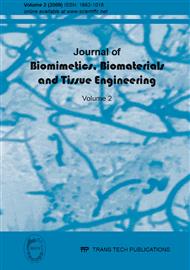p.3
p.15
p.27
p.39
p.59
p.73
Comparison of Electrospun PBSU and PLGA Scaffolds Applied in Vascular Tissue Engineering
Abstract:
Poly(butylenes succinate) (PBSU) had good biocompatibility and biodegradability, but it is left unexplored for the possible application of PBSU in tissue engineering. The aim of this study was to compare PBSU and poly (lactide-co-glycolide) (PLGA) scaffolds prepared by electrospinning technique as vascular tissue engineering materials. Both scaffolds were characterized by fiber morphology, pore structure and mechanical properties. Smooth muscle cells (SMCs) and endothelial cells (ECs) were seeded on the electrospun PBSU and PLGA scaffolds and cultured for different time periods. Cell adhesion and proliferation on the scaffolds were measured by MTT assay, while SEM was used for observing cell morphology on the scaffolds. The results showed that fiber diameter of the electrospun scaffolds ranged from 300nm to 800nm and their porosities were higher than 90%. The electrospun PBSU scaffolds showed a high tensile strength of 2.06±0.11MPa, whereas the ultimate tensile strength of the electrospun PLGA scaffolds reached 14.31±5.24MPa. Cell adhesion efficacy had no significant difference between PBSU and PLGA scaffolds, but cell proliferation rate on PLGA scaffolds was significantly higher than that on PBSU scaffolds after 7 days of culture. Cell morphology was similar on both scaffolds with the polygonal shape for ECs and spindle-like shape for SMCs. From these results, the present in vitro study revealed that as compared to PLGA scaffolds, the electrospun PBSU scaffolds showed lower tensile strength and slower proliferation rate, but as regards the biocompatibility and pore structure, the electrospun PBSU scaffolds had a potential application in vascular tissue engineering.
Info:
Periodical:
Pages:
27-38
Citation:
Online since:
May 2009
Authors:
Price:
Сopyright:
© 2009 Trans Tech Publications Ltd. All Rights Reserved
Share:
Citation:


